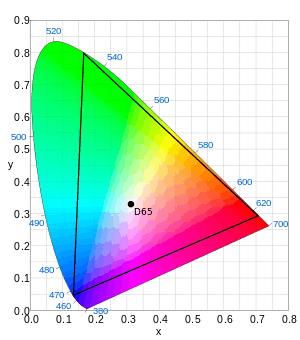Rec. 2100

ITU-R Recommendation BT.2100, more commonly known by the abbreviations Rec. 2100 or BT.2100, defines various aspects of high dynamic range (HDR) video such as display resolution (HDTV and UHDTV), frame rate, chroma subsampling, bit depth, color space, and optical transfer function.[1][2] It was posted on the International Telecommunication Union (ITU) website on July 4, 2016.[1][2] Rec. 2100 expands on several aspects of Rec. 2020.[2]
Resolution
Rec. 2100 defines three resolutions of 1080p, 3840 × 2160 ("4K"), and 7680 × 4320 ("8K").[1] These resolutions have an aspect ratio of 16:9 and use square pixels.[1]
Frame rate
Rec. 2100 specifies the following frame rates: 120p, 119.88p, 100p, 60p, 59.94p, 50p, 30p, 29.97p, 25p, 24p, 23.976p.[1] Only progressive scan frame rates are allowed.[1]
Digital representation
Rec. 2100 defines a bit depth of either 10-bits per sample or 12-bits per sample, with either narrow range or full range color values.[1]
For narrow range color, 10-bits per sample use video levels where the black level is defined as 64, achromatic gray level as 512 and the nominal peak as 940 in RGB encoding and 960 in YCbCr encoding. Codes 0–3 and 1,020–1,023 can be used for the timing reference and should be avoided.[1] 12-bits per sample use 256 as the black level, 2048 as the achromatic gray level and the nominal peak is 3760 in RGB encoding and 3840 in YCbCr encoding.[1] Codes 0–15 and 4,080–4,095 can be used for the timing reference and should be avoided.[1]
For full range color, 10-bit levels are 0 for the black level, 512 for the grey level and 1023 for the nominal peak, and 12-bit levels are 0, 2048 and 4092 (values 4093-4095 are avoided to exclude clipping errors on 10-bit ADC/DAC circuits which have 1023 steps).[1]
System colorimetry
| Color space | White point | Primary colors | ||||||
|---|---|---|---|---|---|---|---|---|
| xW | yW | xR | yR | xG | yG | xB | yB | |
| ITU-R BT.2100 | 0.3127 | 0.3290 | 0.708 | 0.292 | 0.170 | 0.797 | 0.131 | 0.046 |
Rec. 2100 has the same color space as Rec. 2020.[1][2]
Luma coefficients
Rec. 2100 allows for RGB, YCbCr, and ICtCp signal formats with 4:4:4, 4:2:2, and 4:2:0 chroma subsampling.[1] Rec. 2100 specifies that if a luma (Y') signal is made that it use the same R’G’B’ coefficients as Rec.2020: 0.2627 for red, 0.678 for green, and 0.0593 for blue.[1]
Signal formats
Rec. 2100 defines the use of RGB, YCbCr, and ICtCp.[1] ICtCp provides an improved color representation that is designed for high dynamic range (HDR) and wide color gamut signals (WCG).[1][3]
Optical transfer functions
Rec. 2100 defines two sets of HDR optical transfer functions which are perceptual quantization (PQ) and Hybrid Log-Gamma (HLG).[1] HLG is supported in Rec. 2100 with a nominal peak luminance of 1,000 cd/m2 and a system gamma value that can be adjusted depending on background luminance.[1] For a reference viewing environment the peak luminance should be 1,000 cd/m2 or more and the black level should be 0.005 cd/m2 or less.[1] The surround light should be 5 cd/m2 and be neutral grey at standard illuminant D65.[1]
Within each set, the documented transfer functions include an:
- electro-optical transfer function (EOTF) which maps the non-linear signal value into display light
- opto-optical transfer function (OOTF) which maps relative scene linear light to display linear light
- opto-electronic transfer function (OETF) which maps relative scene linear light into the non-linear signal value
See also
- Rec. 2020 - ITU-R Recommendation for UHDTV
References
- 1 2 3 4 5 6 7 8 9 10 11 12 13 14 15 16 17 18 19 20 21 "BT.2100-0 : Image parameter values for high dynamic range television for use in production and international programme exchange". International Telecommunication Union. 2016-07-04. Retrieved 2016-07-04.
- 1 2 3 4 "ITU announces BT.2100 HDR TV standard". Rasmus Larsen. 2016-07-05. Retrieved 2016-07-26.
- ↑ "ICtCp Dolby White Paper" (PDF). Dolby. Retrieved 2016-04-20.